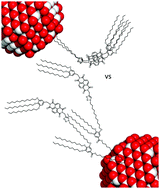Electron accepting naphthalene bisimide ligand architectures for modulation of π–π stacking in nanocrystal hybrid materials†
Abstract
Investigation of charge transfer in quantum dot (QD) systems is an area of great interest. Specifically, the relationship between capping ligand and rate of charge transfer has been studied as a means to optimize these materials. To investigate the role of ligand interaction on the QD surface for electron transfer, we designed and synthesized a series of ligands containing an electron accepting moiety, naphthalene bisimide (NBI). These ligands differ in their steric bulk: as one allows for π–π stacking between the NBI moieties at high surface coverages, while the other does not, allowing for a direct comparison of these effects. Once grafted onto QDs, these hybrid materials were studied using UV-Vis, fluorescence, and transient absorption spectroscopy. Interestingly, the sample with the fastest electron transfer was not the sample with the most NBI π–π stacking, it was instead where these ligands were mixed amongst oleic acid, breaking up H-aggregates between the NBI groups.



 Please wait while we load your content...
Please wait while we load your content...
